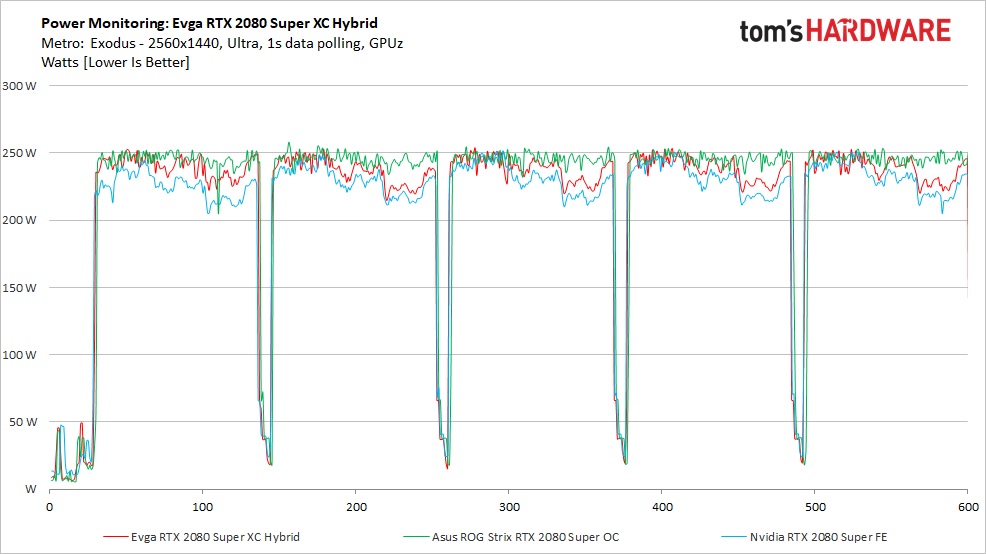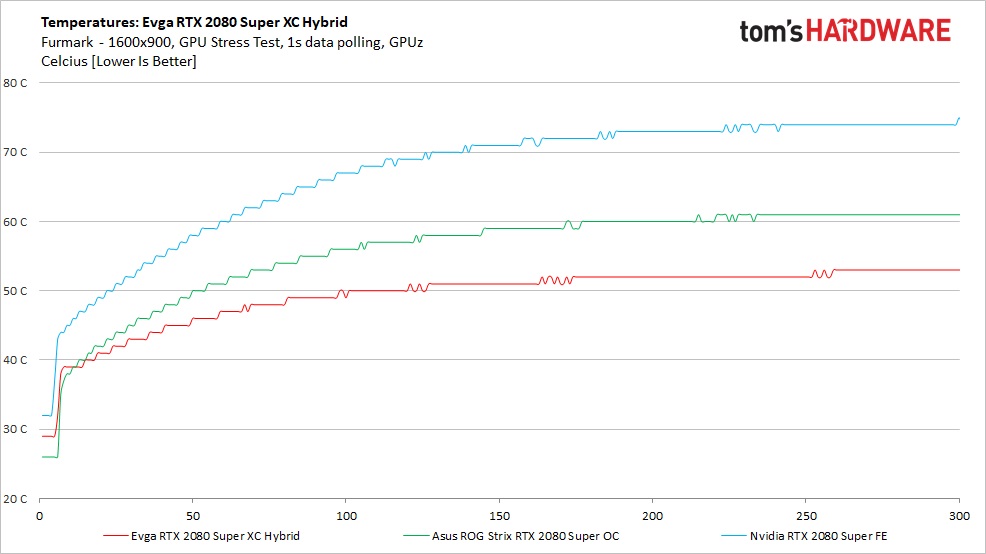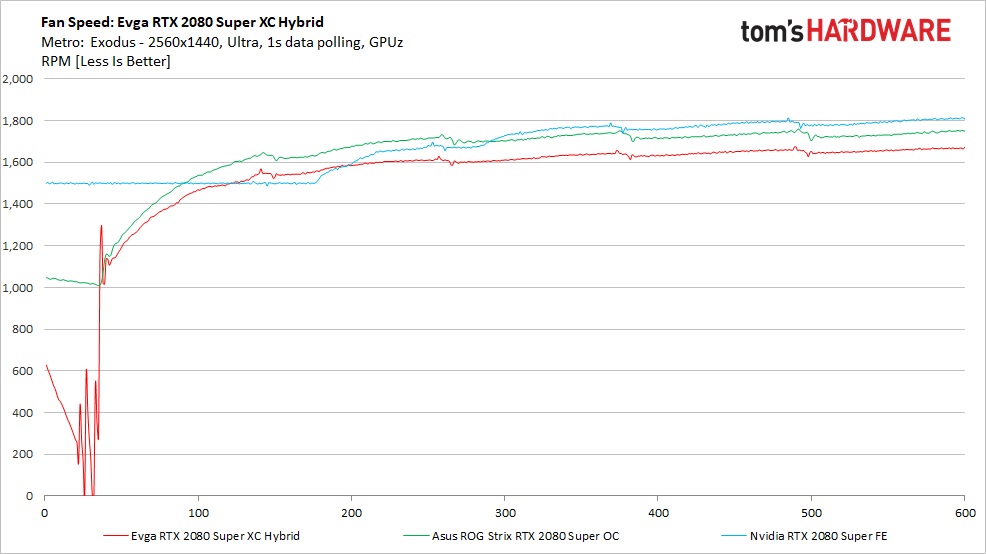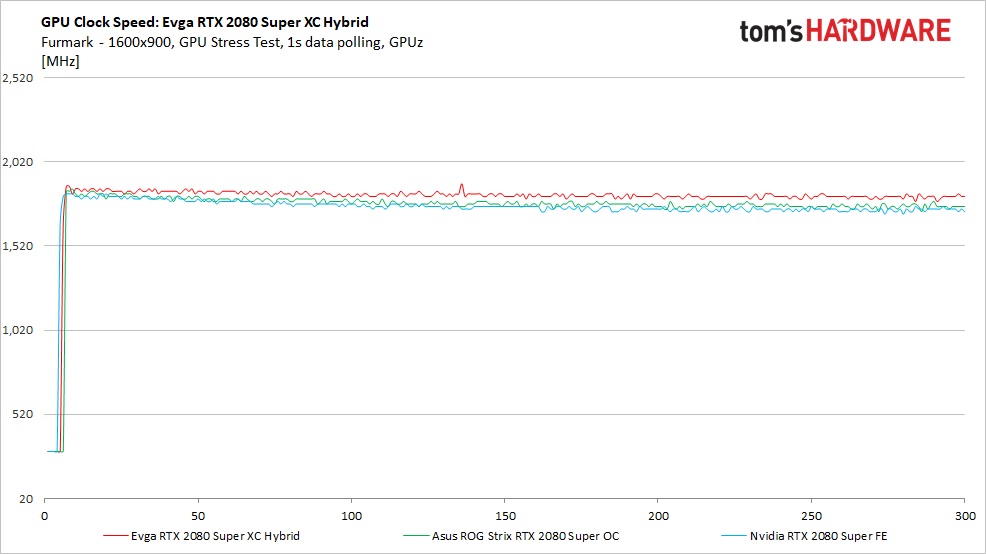Why you can trust Tom's Hardware
We use GPU-Z logging to measure each card's power consumption, temperatures and fan speeds with the Metro Exodus benchmark running at 2560x1440 using the default Ultra settings. The card is warmed up prior to testing and logging is started after settling to an idle temperature (after about 10 minutes). The benchmark is looped a total of five times, which yields around 10 minutes of testing. In the charts, you will see periodic blips in power use that are a result of the benchmark ending one loop and starting the next.
We also use FurMark to capture worst-case power readings. Although both Nvidia and AMD consider the application a 'power virus,' or a program that deliberately taxes the components beyond normal limits, the data we can gather from it offers useful information about a card's capabilities outside of typical gaming loads. For example, certain GPU compute workloads including cryptocurrency mining have power use that can track close to FurMark, sometimes even exceeding it.
Power Draw
Starting off with the gaming power charts, the EVGA RTX 2080 Super XC Hybrid averaged 238W, which puts the card between the Asus ROG Strix at 246W and the RTX 2080 Super FE at 232W. These results fall where expected. Users will be hard-pressed to notice a difference in their electric bill between them.
Looking at the Furmark results, the differences between the cards shrank dramatically with the EVGA and Asus both using 247W while the Founders Edition averaged 248W. This tells us all of these cards have a power limit around the 250W mark, as expected.
Temperatures
Temperatures during game testing reached a peak of 53 degrees Celsius on the EVGA Hybrid card which is 9 degrees Celsius less than the Asus ROG Strix (62C) while the Founders Edition peaked at the highest temperature of 72C. In this short testing, the 120mm AIO did a great job on the GPU temperatures, the lowest we’ve recorded for this test, in fact. Because of the lower temperatures, the EVGA card is able to maintain higher boost bins, as we'll see below.
Temperatures when running Furmark weren’t much different than during the gaming test. Nvidia cards tend to throttle hard when running this stress test so temperatures tend to be similar. The EVGA Hybrid peaked at 53 degrees Celsius, the Asus at 61C, and the Founders Edition at 75C. All coolers are able to keep the cards running here, but the AIO on the EVGA card is again the coolest by far.
Fan Speeds
Fan speeds for the EVGA cover the fan running on the card cooling the VRMs. In this case, it peaked around 1,700 RPM in this testing while the Asus ROG Strix and Founders Edition cards ran faster at 1,750 MHz and 2,000 RPM peaks. The loudest part on the card is the pump, as both the onboard fan and the one attached to the radiator stayed quiet throughout.
Get Tom's Hardware's best news and in-depth reviews, straight to your inbox.
Like temperatures, not much changed with fan speeds either. All card fan speeds ramped up smoothly trying to manage thermals. The EVGA Hybrid’s VRM cooling fan reached around 1,700 RPM, the slowest of the test cards. The fan on the radiator peaked at 1,600 RPM with both operating quietly throughout testing. The pump and its distinct hum will be heard over the fans.
Clock Rates
Clock speeds for the EVGA Hybrid card averaged the highest in our game tests at 1,993 MHz. Compare this to the Asus ROG Strix at 1,988 MHz—only 5 MHz behind. While that isn’t much, the Asus card is supposed to run 30 MHz faster according to the boost clocks. But since the hybrid card kept the GPU cooler than the air-cooled Asus, it reached higher overall boost clocks.
Clock speeds during Furmark dropped tremendously on these Nvidia video cards as is normally the case. Here the EVGA hybrid averaged 1,819 MHz while the Asus ROG Strix used in the test was notably lower at 1,776 MHz. Again we see the benefits of the cooler running EVGA card able to maintain higher clocks. These workloads aren’t typical, so users can expect clocks speeds during gaming to be closer to the game test.
MORE: Best Graphics Cards
MORE: Desktop GPU Performance Hierarchy Table
MORE: All Graphics Content
Current page: Power Consumption, Fan Speeds, Clock Rates and Temperature
Prev Page Performance Results: 3840x2160 (Ultra) Next Page Software: EVGA Precision X1
Joe Shields is a staff writer at Tom’s Hardware. He reviews motherboards and PC components.
-
Phaaze88 The TL;DR:Reply
No, no it is not.
I would've thought a liquid cooled gpu like that would've performed a fair deal better than an air cooled model like the ROG Strix...
Did they take a FE 2080 Super PCB and slap the AIO on it? The FE only has a 280w power limit, and Asus Strix has a 313w limit on the OC model. -
Blas It would be nice to see comparisons of the different hybrid cooled cards out there (EVGA's Hybrid, Gigabyte's Waterforce, Inno3D iChill, etc.). I use these for my iTX build, and apparently there are many differences in noise and cooling performance. And while there are some reviews online, it's really hard to come across comparisons.Reply -
willie_t Some of us like to use the high end cards for Folding. Most card reviewers don't give a single sentence in that area as to how various cards do in that arena. So, we have to search that info out in other areas. "It would be nice" to see a reference in video card reviews - even if it's only a sentence or two.Reply -
saunupe1911 Replyadmin said:The EVGA RTX 2080 Super XC Hybrid performed well, averaging over 100 fps at 1440p ultra and 60 fps at 4K ultra. The hybrid cooling kept the card much cooler than other cards, but the pump has a soft hum. Priced at $789.99, it's one of the most expensive 2080 Super cards available, but only similar Hybrid setups can cool as well.
EVGA RTX 2080 Super XC Hybrid Review: Cool Running, but Worth It? : Read more
Why didn't you guys review the FTW3 version of this card which has a higher boost of 1845Mhz? I paid $769 for it too on Newegg back in September. It's actually going for around the same price right now.
Everything in your review is spot on. It rarely eclipses 53 degrees even when it's working it's hardest. It can overclock it's butt off but I put it back to stock as it's really not necessary since I'm gaming on the Dell S3220DGF monitor. The pump wine does sort of bother me but I've gotten used to it. I wish it could be controlled.
The one real issue with this is card is that the radiator fan can't be software controlled with Precision X1 or Afterburner. You can only independently control the GPU fan. All software reports them running at the same speeds which certainly isn't true. -
PBme Reply
Are you aware of any objective way to test that? F@H doesn't have a benchmark tool (that I'm aware of) and of course they can't just sit there hoping they get a WU, wait for 2 hours, repeat to average results, and just cross their fingers that one WU will be the exact same as another from the same day let alone of months.willie_t said:Some of us like to use the high end cards for Folding. Most card reviewers don't give a single sentence in that area as to how various cards do in that arena. So, we have to search that info out in other areas. "It would be nice" to see a reference in video card reviews - even if it's only a sentence or two.
They can perhaps derive it from the other tests done but that specific one would have to be speculation.







